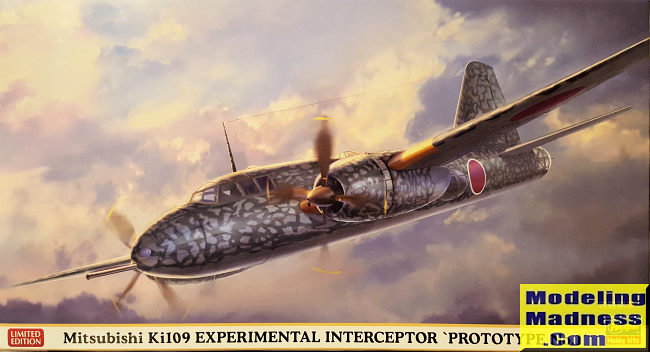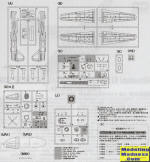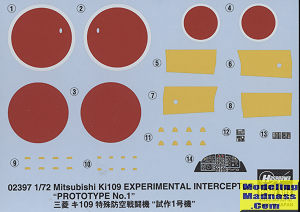
Hasegawa 1/72 Ki-109 Experimental Interceptor 'Prototype No.1'
| KIT #: | 02397 |
| PRICE: | 3800 yen |
| DECALS: | Two options |
| REVIEWER: | Scott Van Aken |
| NOTES: | Includes resin & metal parts. |

| HISTORY |
At the end of 1943, Japanese intelligence was able to obtain very detailed information about the new US heavy bomber B-29 "Superfortress", which was supposed to be used for massive strategic attacks on Japan. In response, it was necessary to create a heavy interceptor fighter capable of destroying high-altitude, well-armed American vehicles. Build a car from scratch? But there was no time left for that.
Specialists of the 1st Aviation Arsenal of the Japanese Army in the city of Tachikawa came to the conclusion that the well-proven Ki-67 heavy bomber would be suitable for these purposes, which by that time had demonstrated excellent speed and maneuverability. The project received the designation Ki-109 and provided for two options: Ki-109a - "killer" with a pair of 37-mm No-203 cannons, mounted tilted under the fuselage, and Ki-109b - "hunter" with a locator and a 40-cm anti-aircraft searchlight ... However, the project was soon revised - at the suggestion of Major Sakamoto, it was decided to install the usual 75-mm Type 88 anti-aircraft gun on the Ki-67. It was assumed that the firing range of this gun, more than 1 km, would allow the fighters to operate without entering the defensive fire zone. Since the army's air headquarters assumed that the B-29s would operate without fighter cover, the project was considered successful. The work was approved in January 1944, and the aircraft retained the designation Ki-109.
The Mitsubishi design team, led by the chief engineer of the project, Kyunosuke Ozawa, developed a new nose and strengthened the Ki-109 fuselage, keeping all the firing points. The first prototype was ready in August 1944, and two months later the B-29s made their first raid on Japan. Ground and air fire tests were conducted by Major Makiura from the Aviation Institute in Tachikawa. The tests were successful, and an order for 44 aircraft followed. The first 22 were powered by two 1900hp air-cooled Mitsubishi Ha-104 engines. Subsequent aircraft were planned to be equipped with Ha-104 Ru with Ru-3 turbochargers, which would improve the fighter's altitude performance, so important for intercepting the B-29. These engines were tested on the second prototype Ki-109, but in reality production aircraft did not receive them.
The only problem with the Ki-109 was its heavy weight, which drastically reduced the aircraft's climb rate. This was unacceptable for the interceptor. To raise the rate of climb on the first prototype aircraft, solid fuel boosters were placed in the bomb bay, but this scheme was not adopted. Starting with the third Ki-109, the turrets were removed and the bomb bay sealed. The fuel supply was reduced (from 5116 liters to 2152 liters). The gun's ammunition consisted of 15 rounds. The gun was manually reloaded by the co-pilot. The defensive armament consisted of a 12.7 mm Type 1 Ho-103 machine gun in the tail mount.
Despite the insufficient altitude characteristics, the Ki-109s were adopted by the 107th Sentai, but by the time a sufficient number of such fighters arrived, the B-29 had already switched to night raids from low altitudes and the Ki-109 was no longer needed. The 107th Sentai was disbanded on July 30, 1945 with nothing to show for all the work.
| THE KIT |
 Hasegawa provides the standard Ki-67 Hiryu kit with resin and metal parts to
make the Ki-109. You get a standard cockpit/interior which is adequate for the
scale. As usual, a decal is supplied for the instrument panel. The very forward
part of the interior has to be removed to make room for the resin nose. One can
build the early or later incarnation of the prototype and if doing the later,
then much of the interior aft of the cockpit can be left off. This is because
the later version has blanking plates for the side and upper fuselage gun
positions.
Hasegawa provides the standard Ki-67 Hiryu kit with resin and metal parts to
make the Ki-109. You get a standard cockpit/interior which is adequate for the
scale. As usual, a decal is supplied for the instrument panel. The very forward
part of the interior has to be removed to make room for the resin nose. One can
build the early or later incarnation of the prototype and if doing the later,
then much of the interior aft of the cockpit can be left off. This is because
the later version has blanking plates for the side and upper fuselage gun
positions.
With the fuselage together, one can turn to building up the wings along with the engine nacelles. The engines are hidden behind a cooling fan and after the prop assemblies are built, they will simply fit into polycaps that you installed when doing the engine nacelles.
On the underside, the landing gear and doors are attached along with the bomb bay doors. One still has to build up the tail gun with its myriad small windows so a masking set would be advisable to help with this and the cockpit. For the cockpit, you can pose entry windows open if you wish. Before installing the resin nose, the hole for the metal canon barrel has to be opened.
 Instructions are well done and cover all the modifications you need to make to
build this version. Decals are simply insignia and wing yellow leading edges.
Both options have the same camouflage scheme as shown on the box art which is an
overall grey-green with heavy Mitsubishi green squiggles over the upper surfaces
and sides.
Instructions are well done and cover all the modifications you need to make to
build this version. Decals are simply insignia and wing yellow leading edges.
Both options have the same camouflage scheme as shown on the box art which is an
overall grey-green with heavy Mitsubishi green squiggles over the upper surfaces
and sides.
| CONCLUSIONS |
Prior to the Hasegawa offering (of which this is not the first), only LS produced this kit. However, the LS kit is undersize, measuring out to around 1/75 scale and it is fairly Spartan as befits a kit from nearly 50 years back. The Hasegawa offering has the benefit of being based on an already excellent kit so construction will cause no additional grey hairs. Note that this version frequently sells out quickly so if you want one, it would be wise to snag one early
September 2022
Copyright ModelingMadness.com. All rights reserved. No reproduction in part or in whole without express permission from the editor.
If you would like your product reviewed fairly and fairly quickly, please contact the editor or see other details in the Note to Contributors.